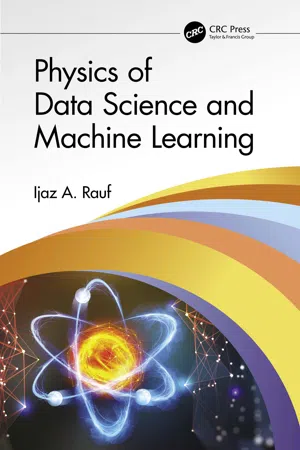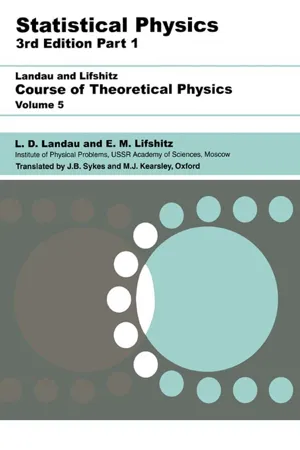Physics
Probabilistic Mechanics
Probabilistic mechanics is a branch of mechanics that incorporates probability theory to analyze and predict the behavior of systems with inherent randomness or uncertainty. It provides a framework for understanding and modeling the probabilistic nature of physical phenomena, such as the behavior of particles at the quantum level or the random fluctuations in materials.
Written by Perlego with AI-assistance
Related key terms
4 Key excerpts on "Probabilistic Mechanics"
- eBook - ePub
- Ijaz A. Rauf(Author)
- 2021(Publication Date)
- CRC Press(Publisher)
CHAPTER 4 Probabilistic PhysicsDOI: 10.1201/9781003206743-4In physics, we soon realize that the universe is too complicated for us to examine anything in one go. Only if we break it into small parts and research them separately, will we make progress. At the microlevel, quantum mechanics explain elementary particles’ behavior, such as the decay of radioactive atoms, the interaction of light with matter, and electrons with magnetic fields, using probabilistic rules as their first principles least in their traditional definition. On the macrolevel, statistical mechanics, in its account of thermodynamic behavior, calls for probabilities in its approach to equilibrium and the second law of thermodynamics. These two entries of probability in modern physics are somewhat distinct.The philosophical analysis of the foundations of a theory often lags the discovery of the mathematical results that form its basis in the exact sciences’ philosophy. The probability theory is no exception. Questions concern both the differences between formalism and the intuitive conceptions of probability and the interrelationships between the intuitive concepts. Often, we will create a mathematical model that reproduces certain features of one of those pieces, and we believe progress has been made. As knowledge progresses, we can develop more and more models, more accurately reproducing features of the real world. No one knows whether this process will end naturally or whether it will continue indefinitely. - eBook - ePub
Statistical Physics
Volume 5
- L D Landau, E.M. Lifshitz(Authors)
- 2013(Publication Date)
- Butterworth-Heinemann(Publisher)
t ) and determining the required mean value asThe foregoing discussion shows that the deductions and predictions concerning the behaviour of macroscopic bodies which are made possible by statistical physics are probabilistic. In this respect statistical physics differs from (classical) mechanics, the deductions of which are entirely deterministic. It should be emphasised, however, that the probabilistic nature of the results of classical statistics is not an inherent property of the objects considered, but simply arises from the fact that these results are derived from much less information than would be necessary for a complete mechanical description (the initial values of the coordinates and momenta are not needed).In practice, however, when statistical physics is applied to macroscopic bodies, its probabilistic nature is not usually apparent. The reason is that, if any macroscopic body (in external conditions independent of time) is observed over a sufficiently long period of time, it is found that all physical quantities describing the body are practically constant (and equal to their mean values) and undergo appreciable changes relatively very rarely; we mean, of course, macroscopic quantities describing the body as a whole or macroscopic parts of it, but not individual particles.† This result, which is fundamental to statistical physics, follows from very general considerations (to be discussed in § 2 ) and becomes more and more nearly valid as the body considered becomes more complex and larger. In terms of the statistical distribution, we can say that, if by means of the function (p, q ) we construct the probability distribution function for various values of the quantity f (p, q ), this function will have an extremely sharp maximum for - eBook - ePub
Laws of Chaos
A Probabilistic Approach to Political Economy
- Emmanuel Farjoun, Moshe Machover(Authors)
- 2020(Publication Date)
- Verso(Publisher)
statistical mechanics, first developed by Maxwell and Boltzmann over one hundred years ago. Of course, we do not propose simply to transcribe the theorems of statistical mechanics into economic language. Rather, we would like to use the methods of that science as a rough and general guide, and to point out broad analogies that can serve to illuminate certain economic problems and arguments, including some of the points discussed in the introduction. We shall also use this setting to introduce some of the probabilistic ideas and techniques, which we shall later apply in an economic context. (A reader who is unfamiliar with statistical mechanics need not panic: no detailed knowledge of that subject will be required, and the ideas referred to will be explained in an elementary way.)The purpose of statistical mechanics is to explain the macroscopic physical properties and behaviour of material systems consisting of a very large number of elementary constituent particles. The simplest (and oldest) example of such a treatment concerns the physical behaviour of gases under various (and varying) conditions of temperature and pressure. (The theory in fact reduces these macroscopically observable parameters, temperature and pressure, via a statistical analysis, to the microscopic behaviour of the molecules of which a gas is made up.) The theoretical model used for this purpose is that of an ideal gas, to which we shall now turn.Consider a quantity of ‘gas’ enclosed in a container, which for the sake of simplicity we imagine to be cubic in shape. The ideal gas is supposed to consist of a vast number of particles, or ‘molecules’. In the simplest cases, that of a simple monatomic gas, which is the only one we need to consider here, these particles are all identical and have no constituent parts of their own.2Let us suppose that the system is isolated: the container is hermetically closed and thermally insulated; the volume and temperature of the gas (and hence also its pressure) remain constant. Even if initially perturbed, the system will eventually reach a state of equilibrium. This does not mean, however, that the particles of the gas will come to rest; on the contrary, they persist in vigorous motion, ever colliding with each other and with the walls of the vessel. Thus each particle continuously changes its position, and frequently (many thousands of times each second) also its speed and direction as a result of these collisions. - eBook - ePub
- Maurice Lemaire, Alaa Chateauneuf, Jean-Claude Mitteau(Authors)
- 2013(Publication Date)
- Wiley-ISTE(Publisher)
Chapter 2Preliminary Approach to Reliability in Mechanics
Before discussing reliability in mechanics, we must specify the context in which the proposed approach is relevant. In fact, reliability covers both widely used methods, like the use of statistical techniques for production control, and new methods concerning failure modes and contributing to risk evaluation. These new methods rely on an approach which is still novel and whose underlying philosophy must be defined.It is therefore the purpose of this chapter to describe the context and the objective with the aid of general concepts, in the hope of arousing in the reader an interest for a reliability approach to design.2.1 General points2.1.1 Reliability methods in mechanics
We are interested in methods that are developed primarily in relation to the modeling of materials and structures. They allow mechanics to take advantage of many advances made in scientific disciplines, like the theory of probability, and experiments in other technological fields. They are characterized by a close relationship with mechanical behavior models. In the words of Hasofer (author, with Lind, of the first invariant definition of the reliability index [HL74]), they ‘offer an additional precision’ to the designer.The designer plans structures and machines whose development and operating conditions, throughout the expected lifespan, are not perfectly known: design takes place in an imprecise and uncertain universe, which can be, at least in certain cases, modeled by a random hazard. This is not the only modeling approach possible, and some have suggested the use of fuzzy sets; this is not always possible: gross error, or even blunder, is not probabilizable!By accepting a probability-based approach, reliability methods in mechanics help calculate reliability estimates: the notional
Index pages curate the most relevant extracts from our library of academic textbooks. They’ve been created using an in-house natural language model (NLM), each adding context and meaning to key research topics.



